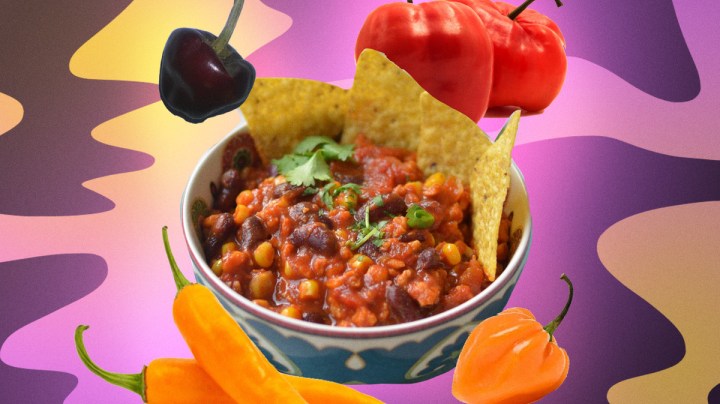Aji Amarillo
Used in Peru and Bolivia, the name of this chile means “yellow chile.” In Peru, the aji amarillo along with garlic and red onion is consider the country’s “holy trinity” of their cuisine.

Art by Stephany Torres for Remezcla
Chili lovers across the globe may never agree about whether it’s OK to add beans to the delicious dish, but for today, at least, fans of the spicy stew should put their frijole disagreement on the back burner and focus on something more important.
Today (Feb. 25) is National Chili Day. Chili, of course, is short for chili con carne (or chile con carne). The hearty meal can be traced back to the early 16th century writings of Bernardino de Sahagún, a Franciscan friar who wrote of a chili pepper-seasoned stew being eaten in the Aztec capital of Tenochtitlan. The world “chili” comes from the Nahuatl language.
According to Eater, “Chili…was originally popularized by women, most of them Tejanas or Mexican” in San Antonio, Texas. They were known as “chili queens,” who would serve pots of chili in the plazas to customers during the 19th century.
An author named Edward King wrote about chile con carne in a magazine travel story in 1874 calling it a “savory compound swimming in fiery pepper.”
Around the same time, another reporter visiting San Antonio wrote about a “seductive looking” dish “of Mexican origin.”
“They always have enough to go around, for no stranger, no matter how terrific a durned fool he is, ever calls for a second dish,” the anonymous reporter wrote. “He almost always calls for a big cistern full of water, and you can’t put the water in him fast enough with a steam engine hose.”
If you have a few gallons of water and are ready to spice up your own chile con carne today, here are five chiles to consider introducing to your pot. Aprovecho!
Used in Peru and Bolivia, the name of this chile means “yellow chile.” In Peru, the aji amarillo along with garlic and red onion is consider the country’s “holy trinity” of their cuisine.
These South American chiles are said to have been around for the last 8,000 years. Unlike most chiles, they are found in mountainous regions because they can survive cold weather.
Known for their hot and fruity flavor, these chiles are popular in hot sauces. Habaneros originate from the Amazon. Today, most of them come from the Yucatán Peninsula in Mexico. It was once known as the world’s hottest chile about 20 years ago.
This chili is also known as the “rattle chili” because when seeds loosen inside it, it sounds like a rattle when shaken. Farmers cultivate the chili in Mexico, including in the states of Guerrero, Coahuila, Jalisco and Durango.
Produced only in the hilly Oaxaca region of southern Mexico, these chiles have a smoky character and do not produce as much heat as the chipotle.